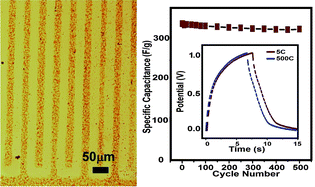Micro-supercapacitors are a promising candidate whose reliability and performances are struggling to meet the energy demands dictated by the incoming generation of miniaturized electronic devices. In this paper, we describe a facile and low-cost method for fabricating flexible and all-solid-state micro supercapacitors by microfluidic etching. The micro-supercapacitor configuration is composed of sub-10-nm-scale MnO2 nanoparticle interdigital microelectrode fingers prepared by microfluidic etching with H3PO4-PVA thin films as both the solid-state electrolyte and the flexible substrate. The entire device shows outstanding electrochemical performances with high specific capacitance and stable cycle life, and the performance can be mostly preserved even conditions of under repeated bending. The technique we describe here is a universal method for fabricating a micro-supercapacitor, since the microfluidic etching can be extended to most active materials which can be used for energy- and power-devices, and there are many other choices for the solid electrolyte. Thus, these micro-supercapacitors provide a promising power source in microelectromechanical systems (MEMS), wearable electronics and other general requirements.

You have access to this article
 Please wait while we load your content...
Something went wrong. Try again?
Please wait while we load your content...
Something went wrong. Try again?


 Please wait while we load your content...
Please wait while we load your content...